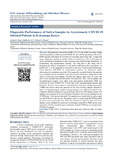Diagnostic Performance of Saliva Samples in Asymtomatic COVID-19 Infected Patients in Kakamega Kenya

View/
Date
2024-02Author
Njue, Lilian G.
Ali, Iddah M.
Menza, Nelson C.
Metadata
Show full item recordAbstract
Abstract: The pandemic coronavirus SARS‐CoV‐2 in the world has caused a large infected population suffering from COVID‐19. To curb the spreading of the virus, WHO urgently demanded an extension of screening and testing; thus, a rapid and simple diagnostic method is needed which is non-invasive. Use of self-collected saliva can minimize healthcare worker exposure and expand testing capabilities for symptomatic and asymptomatic patients. The main aim of this study was to document the ability of patients to self-collect sufficient saliva specimens for SARS-CoV-2 in the quantitative detection by Reverse Transcriptase Polymerase Chain Reaction (RT-PCR) in asymptomatic patients by themselves under observation by a healthcare provider. The researcher recorded whether the patients were confident and the suitability of the specimen for laboratory testing that would inform clinical decision making. Seventy-one patients aged from 13 years and above were included between December 2020 and July, 2021. Saliva samples and Nasopharyngeal samples were taken from each patient. Quantitative PCR was performed to detect SARS-CoV-2 viral load in the nasopharyngeal samples and qualitative Reverse Transcriptase Loop-mediated isothermal amplification (RT-LAMP) was used to detect the presence of the virus in saliva samples. Results of saliva vs. nasopharyngeal samples testing using the two different methods were compared. Statistical analyses were performed. Out of the 350 samples tested, 314 samples were found to be Covid 19 positive. Result of the test was validated by the RT-PCR test. This showed that only 314 samples were tested both by saliva rapid test and PCR test while the rest 36 samples were not tested using RT-PCR method but were tested using saliva test. Thus, the salivary test based on pure oral saliva samples easily obtained by noninvasive techniques using RT-LAMP has the same agreement with the nasopharyngeal technique using RT-PCR one in asymptomatic COVID-19 patients.
Collections
- Staff Collection [24]
